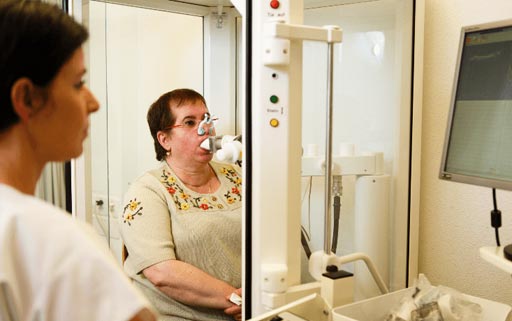Exhaled Breath Test Discriminates COPD
By LabMedica International staff writers
Posted on 28 Jun 2017
Chronic obstructive pulmonary disease (COPD) is a type of obstructive lung disease characterized by long-term poor airflow. The main symptoms include shortness of breath and cough with sputum production. COPD is a progressive disease, meaning it typically worsens over time.Posted on 28 Jun 2017
Analysis of exhaled breath by real-time mass spectrometry helps discriminate between patients with chronic obstructive pulmonary disease (COPD), healthy controls, and patients with asthma. COPD is presently diagnosed based upon airflow restriction in spirometry, respiratory symptoms, and history of exposure to risk factors.

Image: A patient undergoing a breath test for chronic obstructive pulmonary disease and other lung diseases (Photo courtesy of Professor Malcolm Kohler, MD).
Scientists at the University Hospital Zurich (Switzerland) compared 49 patients with COPD whose mean age was 64 years 59.2% were male; 53 healthy control subjects whose mean age was 43 years and 52.8%were female, and 31 patients with asthma whose mean age was 41 years and 64.5% were male. The team used secondary electrospray ionization/high-resolution mass spectrometry to define a series of potential markers in exhaled breath with the potential to discriminate patients with COPD from healthy controls.
The team identified 57 specific COPD discriminatory markers, with a further 56 that overlapped with the control subjects, and 17 with the subjects with asthma, all 17 of which were common to all of these patients. Identification of 23 compounds using real-time mass spectrometry that best defined signals significantly correlated with forced expiratory volume in one second predicted (FEV1%-predicted) in terms of the FEV1/ forced vital capacity (FVC-predicted) ratio. These compounds generally belong to the oxidative stress cascade and the lipolysis cascade. Patients with COPD showed FEV1 44.6, FVC 75.8, and FEV1/FVC ratio of 44. The healthy control subjects showed FEV1 101.2, FVC 105.3, and FEV1/FVC ratio of 81. Patients with asthma had FEV1 84.4, FVC 99.5, and FEV1/FVC ratio of 70.
Yvonne Nussbaumer-Ochsner, MD, the lead author, said, “There are more biomarkers overlapping with the control group than with asthma, which is actually also a kind of chronic obstructive airways disorder. Asthmatics appear to have different biomarkers in their exhaled breath compared with both controls and patients with COPD.” The study was presented on June 8, 2017, at the Joint CHEST-Swiss Society of Pneumology Congress (CHEST-SGP) held in Basel, Switzerland.
Related Links:
University Hospital Zurich








 (3) (1).png)
 Analyzer.jpg)




